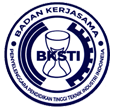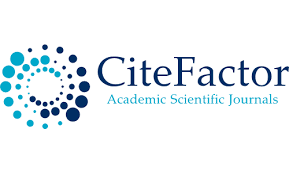Implementation of Reverse Logistics System in the Metal Industry Using Supply Chain Operation References (SCOR) Model with Analytical Hierarchy Process (AHP) Method
Abstract
Keywords
Full Text:
PDFReferences
Anindita, K., Ambarawati, I. G. A. A. and Dewi, R. K. (2020) ‘Kinerja Rantai Pasok Di Pabrik Gula Madukismo Dengan Metode Supply Chain Operation Reference-Analytical Hierarchy Process (Scor-Ahp)’, Agrisocionomics: Jurnal Sosial Ekonomi Pertanian, 4(1), pp. 125–134. doi: 10.14710/agrisocionomics.v4i1.6080.
Agrawal, S., Singh, R. K., & Murtaza, Q. (2016). Disposition decisions in reverse logistics by using AHP-fuzzy TOPSIS approach. Journal of Modelling in Management, 11(4), 932-948. https://doi.org/10.1108/JM2-12-2014-0091
Apriyani, Nadia, A., and Yunita, I. (2021). Barrier dalam Implementasi Reverse Logistics: Literature Review. Proceeding MBCIE 3rd, 3. ISSN 978-623-93423-1-9
Azimifard, A., Moosavirad, S. H., & Ariafar, S. (2018). Selecting sustainable supplier countries for Iran's steel industry at three levels by using AHP and TOPSIS methods. Resources Policy, 57, 30-44. https://doi.org/10.1016/j.resourpol.2018.01.002
Davoodi, S. M. R., Mohammadpour Dehkordi, H., & Rahmati Dehkordi, M. (2021). Identification of Factors Affecting Blockchain Technology in Sustainable Supply Chain of the Steel Industry Using SPCA and KPCA Methods. Journal of Industrial Strategic Management, 6(3), 99-121. Doi: 20.1001.1.25382756.2021.6.3.7.8
Fauziyah, I. S., Ridwan, A. Y., & Muttaqin, P. S. (2020, December). Food production performance measurement system using halal supply chain operation reference (SCOR) model and analytical hierarchy process (AHP). In IOP Conference Series: Materials Science and Engineering (Vol. 909, No. 1, p. 012074). IOP Publishing. doi: 10.1088/1757-899X/909/1/012074
Guarnieri, P., Cerqueira-Streit, J. A., & Batista, L. C. (2020). Reverse logistics and the sectoral agreement of packaging industry in Brazil towards a transition to circular economy. Resources, conservation and recycling, 153, 104541. https://doi.org/10.1016/j.resconrec.2019.104541
Hahn, G. J. (2020). Industry 4.0: a supply chain innovation perspective. International Journal of Production Research, 58(5), 1425-1441. https://doi.org/10.1080/00207543.2019.1641642
Hasibuan, A., Arfah, M., Parinduri, L., Hernawati, T., Harahap, B., Sibuea, S. R., & Sulaiman, O. K. (2018, April). Performance analysis of supply chain management with supply chain operation reference model. In Journal of Physics: Conference Series (Vol. 1007, No. 1, p. 012029). IOP Publishing. doi: 10.1088/1742-6596/1007/1/012029
Hidayati, A., & Pulansari, F. (2023). Performance Measurement Supply Chain Management (SCM) Using the Supply Chain Operation Reference (SCOR) Method at PT X. Indonesian Journal of Industrial Engineering & Management, 4(2), 173-183. http://dx.doi.org/10.22441/ijiem.v4i2.20506
Jain, V. and Khan, S. A. (2017) ‘Application of AHP in reverse logistics service provider selection: A case study’, International Journal of Business Innovation and Research, 12(1), pp. 94–119. doi: 10.1504/IJBIR.2017.080711.
Jain, N., & Singh, A. R. (2020). Sustainable supplier selection criteria classification for Indian iron and steel industry: a fuzzy modified Kano model approach. International Journal of Sustainable Engineering, 13(1), 17-32. https://doi.org/10.1080/19397038.2019.1566413
Javad, M. O. M., Darvishi, M., & Javad, A. O. M. (2020). Green supplier selection for the steel industry using BWM and fuzzy TOPSIS: A case study of Khouzestan steel company. Sustainable Futures, 2, 100012. https://doi.org/10.1016/j.sftr.2020.100012
Khan, M. R., Alam, M. J., Tabassum, N., & Khan, N. A. (2022). A Systematic review of the Delphi–AHP method in analyzing challenges to public-sector project procurement and the supply chain: A developing country’s perspective. Sustainability, 14(21), 14215. https://doi.org/10.3390/su142114215
Kumar, S., Kumar, S., & Barman, A. G. (2018). Supplier selection using fuzzy TOPSIS multi criteria model for a small scale steel manufacturing unit. Procedia computer science, 133, 905-912. https://doi.org/10.1016/j.procs.2018.07.097
Kuswandi, R. Y., Ridwan, A. Y., & Maâ, R. (2018). Perancangan Sistem Monitoring Reverse Logistic Untuk Industri Penyamakan Kulit Dengan Model Scor Di Pt Elco. eProceedings of Engineering, 5(3).
Kuswandi, R. Y., Ridwan, A. Y., & Ma’ali El Hadi, R. (2018, October). Development of monitoring reverse logistic system for leather tanning industry using scor model. In 2018 12th International Conference on Telecommunication Systems, Services, and Applications (TSSA) (pp. 1-5). IEEE. doi: 10.1109/TSSA.2018.8708836
Lamba, D., Yadav, D. K., Barve, A., & Panda, G. (2020). Prioritizing barriers in reverse logistics of E-commerce supply chain using fuzzy-analytic hierarchy process. Electronic Commerce Research, 20, 381-403. https://doi.org/10.1007/s10660-019-09333-y
Lee, K., Azmi, N., Hanaysha, J., Alzoubi, H., & Alshurideh, M. (2022). The effect of digital supply chain on organizational performance: An empirical study in Malaysia manufacturing industry. Uncertain Supply Chain Management, 10(2), 495-510. doi: 10.5267/j.uscm.2021.12.002
Liputra, D. T., Santoso, S. and Susanto, N. A. (2018). ‘Pengukuran Kinerja Rantai Pasok Dengan Model Supply Chain Operations Reference (SCOR) dan Metode Perbandingan Berpasangan’, Jurnal Rekayasa Sistem Industri, 7(2), p. 119. doi: 10.26593/jrsi.v7i2.3033.119-125.
Maheswari, H., Sigit Santoso, A. and Putri Kuncoro, D. (2016) ‘Pengaruh Kegiatan Reverse logistic Terhadap Kinerja Supplier Chain Position Industri Telepon Selular’, Jurnal Ilmiah Manajemen dan Bisnis, 2(2), pp. 715–737. http://dx.doi.org/10.22441/jimb.v2i2.3712
Marfuah, U. and Mulyana, A. (2021) ‘Pengukuran Kinerja Rantai Pasok Pada Pt . Sip Dengan Pendekatan Scor Dan Analysis Hierarcy Process ( Ahp )’, Jurnal Integrasi Sistem Industri, 8(2), pp. 25–33. https://doi.org/10.24853/jisi.8.2.25-33
Maryam, S. and Pratama, A. (2016) ‘Analisis Pemilihan Supplier Pada Proses Procurement Di Pt. M3 Ketapang Sejahtera Dengan Metode Fuzzy Ahp Dan Software Smartpicker’, Jurnal PASTI, 10(1), pp. 62–71. p-ISSN: 2085-5869 / e-ISSN: 2598-4853.
Mugurusi, G., & Ahishakiye, E. (2022). Blockchain technology needs for sustainable mineral supply chains: A framework for responsible sourcing of Cobalt. Procedia Computer Science, 200, 638-647. https://doi.org/10.1016/j.procs.2022.01.262
Mursyid, M. S., & Wahyuni, H. C. (2020). Pengukuran Kinerja Rantai Pasok dengan Menggunakan Supply Chain Operation Reference (Scor) Berbasis Analytical Hierarchy Process (Ahp) pada PT. Msm. International Journal on Economics, Finance and Sustainable Development, 2(4), 35-39. ISSN (electronic): 2620-6269/ ISSN (printed): 2615-4021.
Nugraha, I., Hisjam, M., & Sutopo, W. (2019, August). Sustainable criteria in supplier evaluation of the food industry. In IOP Conference Series: Materials Science and Engineering (Vol. 598, No. 1, p. 012006). IOP Publishing. doi: 10.1088/1757-899X/598/1/012006
Nugraha, I., Hisjam, M., & Sutopo, W. (2020, October). Aggregate planning method as production quantity planning and control to minimizing cost. In IOP Conference Series: Materials Science and Engineering (Vol. 943, No. 1, p. 012045). IOP Publishing. doi: 10.1088/1757-899X/943/1/012045
Paduloh, P., Mitta, D. K., Sumanto, S., & Rosihan, R. I. (2020). ANALYSIS OF REVERSE SUPPLY CHAIN PERFORMANCE IN BEEF INDUSTRY WITH THE SUPPLY CHAIN OPERATION REFERENCE METHOD. Jurnal Teknologi Industri Pertanian, 30(3), 329-337. https://doi.org/10.24961/j.tek.ind.pert.2020.30.3.329
Paula, I. C. D., Campos, E. A. R. D., Pagani, R. N., Guarnieri, P., & Kaviani, M. A. (2020). Are collaboration and trust sources for innovation in the reverse logistics? Insights from a systematic literature review. Supply Chain Management: An International Journal, 25(2), 176-222. https://doi.org/10.1108/SCM-03-2018-0129
Pinto, J. T., & Diemer, A. (2020). Supply chain integration strategies and circularity in the European steel industry. Resources, Conservation and Recycling, 153, 104517. https://doi.org/10.1016/j.resconrec.2019.104517
Prakash, C., & Barua, M. K. (2015). Integration of AHP-TOPSIS method for prioritizing the solutions of reverse logistics adoption to overcome its barriers under fuzzy environment. Journal of Manufacturing Systems, 37, 599-615. https://doi.org/10.1016/j.jmsy.2015.03.001
Pulansari, F., Rahmawati, N., Nugraha, I., Ardysti, A. R., Permana, H. N., & Zahirah, J. F. (2022). Reverse Logistics Performance Assessment in the Construction Industry Sector. Nusantara Science and Technology Proceedings, 336-341. https://doi.org/10.11594/nstp.2022.2750
Putri, I. W. K., & Surjasa, D. (2018). Pengukuran Kinerja Supply Chain Management Menggunakan Metode SCOR (Supply Chain Operation Reference), AHP (Analytical Hierarchy Process) dan OMAX (Objective Matrix) di PT. X. Jurnal Teknik Industri, 8(1), 37-46. https://doi.org/10.25105/jti.v8i1.4719
Qurtubi, Q., Yanti, R., & Maghfiroh, M. F. (2022). Supply chain performance measurement on small medium enterprise garment industry: application of supply chain operation reference. Jurnal Sistem Dan Manajemen Industri, 6(1), 14-22. https://doi.org/10.30656/jsmi.v6i1.4536
Rakhman, A., Machfud, M. and Arkeman, Y. (2018) ‘Kinerja Manajemen Rantai Pasok dengan Menggunakan Pendekatan Metode Supply Chain Operation Reference (SCOR)’, Jurnal Aplikasi Bisnis dan Manajemen, 4(1), pp. 106–118. https://doi.org/10.17358/jabm.4.1.106
Saragih, S., Pujianto, T. and Ardiansah, I. (2021) ‘Pengukuran Kinerja Rantai Pasok pada PT. Saudagar Buah Indonesia dengan Menggunakan Metode Supply Chain Operation Reference (SCOR)’, Jurnal Ekonomi Pertanian dan Agribisnis, 5(2), pp. 520–532. doi: 10.21776/ub.jepa.2021.005.02.20.
Septifani, R., Effendi, U., & Dewi, I. A. (2012). Penilaian Kinerja Departemen Produksi dalam Menerapkan Reverse Logistics dengan Pendekatan Analytical Hierarchy Process dan Data Envelopment Analysis (Studi Kasus Di PT Sinar Sosro Kantor Pabrik Mojokerto). Industria: Jurnal Teknologi dan Manajemen Agroindustri, 1(2), 94-104. ISSN 2252-7877 (Print); ISSN 2549-3892 (Online).
Sirisawat, P., & Kiatcharoenpol, T. (2018). Fuzzy AHP-TOPSIS approaches to prioritizing solutions for reverse logistics barriers. Computers & Industrial Engineering, 117, 303-318. https://doi.org/10.1016/j.cie.2018.01.015
Sucipta, I., Widia, I. and Utama, I. (2016) ‘Strategi Peningkatan Kinerja Manajemen Rantai Pasokan Jeruk Siam Di Kelompok Tani Gunung Mekar Kabupaten Gianyar Demo’, Jurnal BETA (Biosistem dan Teknik Pertanian), 4(2), pp. 27–35. ISSN 2502-3012. https://ojs.unud.ac.id/index.php/beta/article/view/23654
Solodovnikov, V. (2019). Supply chain planning methodology for metals. Machines. Technologies. Materials., 13(4), 171-172. WEB ISSN 1314-507X; PRINT ISSN 1313-0226
Valenzuela, J., Alfaro, M., Fuertes, G., Vargas, M., & Sáez-Navarrete, C. (2021). Reverse logistics models for the collection of plastic waste: A literature review. Waste Management & Research, 39(9), 1116-1134. https://doi.org/10.1177/0734242X211003948
Van den Brink, S., Kleijn, R., Sprecher, B., & Tukker, A. (2020). Identifying supply risks by mapping the cobalt supply chain. Resources, Conservation and Recycling, 156, 104743. https://doi.org/10.1016/j.resconrec.2020.104743
Wibowo, M. A., Sholeh, M. N., & Adji, H. S. (2017). Supply chain management strategy for recycled materials to support sustainable construction. Procedia engineering, 171, 185-190. https://doi.org/10.1016/j.proeng.2017.01.325
Xun, D., Sun, X., Liu, Z., Zhao, F., & Hao, H. (2022). Comparing supply chains of platinum group metal catalysts in internal combustion engine and fuel cell vehicles: A supply risk perspective. Cleaner Logistics and Supply Chain, 4, 100043. https://doi.org/10.1016/j.clscn.2022.100043
Yuliawati, E., & Suroso, H. C. (2021). Critical barriers in reverse logistics implementation: Case study on construction machinery remanufacturing company in Indonesia. Jurnal IPTEK, 25(2), 93-102. https://doi.org/10.31284/j.iptek.2021.v25i2.1429
Yusnawati, Y., Handayani, N., & Nadya, Y. (2020). Rancangan Model Supply Chain UKM Jamur DI Kota Langsa Dengan menggunakan metode SCOR. Jurnal Teknologi, 12(2), 167-176. https://doi.org/10.24853/jurtek.12.2.167-176
DOI: http://dx.doi.org/10.22441/ijiem.v5i2.23366
Refbacks
- There are currently no refbacks.

This work is licensed under a Creative Commons Attribution-NonCommercial 4.0 International License.
IJIEM - Indonesian Journal of Industrial Engineering & Management
Program Pascasarjana Magister Teknik Industri Universitas Mercu Buana
Kampus Menteng - Gedung Tedja Buana, Floor 4th
Jl. Menteng Raya No. 29 Jakarta Pusat- Indonesia
Tlp.: +62 21 31935454 Fax: +62 21 31934474
http://publikasi.mercubuana.ac.id/index.php/ijiem
Email: [email protected]

This work is licensed under a Creative Commons Attribution-NonCommercial 4.0 International License.
The journal is indexed by:





1.png)
.png)
.png)
.png)







